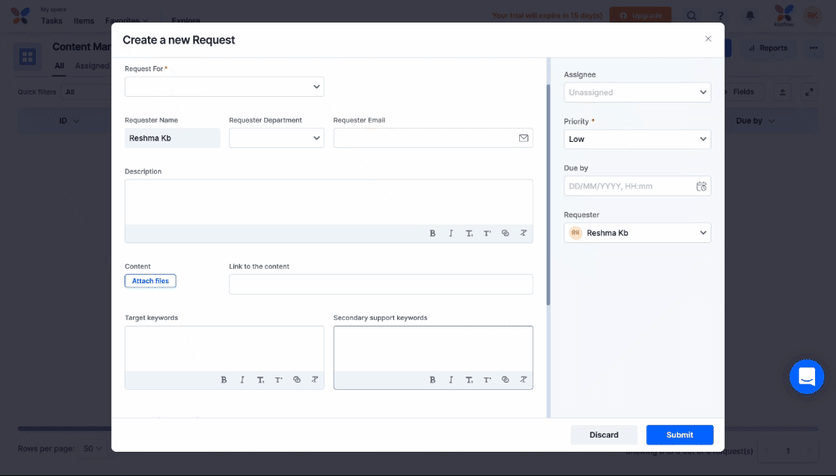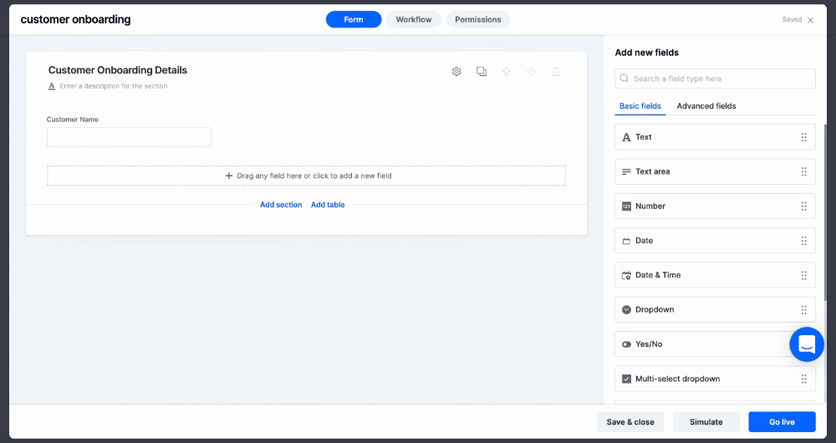.webp?width=500&height=300&name=What%20is%20Zero-Code_%20A%20Complete%20Guide%20to%20Zero-Code%20Development_og%20(1).webp)
- >
- Low-Code Platform >
- What is Zero-Code? A Complete Guide to Zero-Code Development
What is Zero-Code? A Complete Guide to Zero-Code Development
What is Zero-Code?
Zero-Code is a technique that allows you to build web applications using drag-and-drop features and without a single line of code.With drag-and-drop features and ready-made or pre-existing building blocks, users can automate processes, digitize operations, and bundle them into their everyday apps without writing any code manually.
Using a platform with zero-code capabilities elevates the productivity of your teams by enabling them to create workflows and useful applications with reduced errors.
What is Zero-Code Development?

Zero-code development is a type of web development that lets users create apps in a visual development interface without the need for IT intervention. It enables fellow business users with little or no programming skills to create functional apps.
For a deeper understanding of how these development methods differ, explore this detailed low-code vs no-code comparison to see where zero-code fits in.
What is Zero-Code Framework?
Zero-code framework means an emerging, lightweight, simple, easy, and extendable open-source framework for writing test code in JSON or YAML format. It also facilitates declarative configurated coupled with low code automation. Zero-code, put simply, reduces the complexity and brings a sense of simplicity to modern API automation.
Who are zero-code developers?
Zero-code developers, also called citizen developers, use visual interfaces and drag-and-drop tools to build applications without writing any code. Citizen developers often carry wholesome business knowledge and a good understanding of business requirements. They use zero-code tools that allow people with little or no programming skills to create complex systems and applications. Zero-code tools feature pre-built components and modules that can be easily combined and customized to fit specific needs.
With a Zero-code approach, application development can be faster and more accessible than traditional coding. It can enable a wider range of people to create and deploy their own applications.
The low-code and no-code development platform market has experienced significant growth. In 2016, Forrester estimated that the total market for low-code development platforms would grow to $15.5 billion by 2020[1].
Learn more: Difference between Low-Code vs High-Code
What Do Zero-Code Development Have to Offer?
In today’s industries, citizen developers are quickly becoming a staple. Citizen developers are people whose job function lies at the intersection of business and technology. They might know how to code but minimally so. For instance, people in job roles like business analysts, project managers, product managers, etc.
However, in order to enable anyone on the team to build what they want to build faster (regardless of their coding knowledge), there needs to be a key enabler.
Zero-code platform helps to bridge the gap between business and IT in terms of development and innovation.
It delivers a slew of functionality to battle against the traditional development methods. The versatile features of these systems offer some end users a first taste of what they expect and how apps can function. Prototyping can be paralleled between business and IT.
While zero-code have certain features similar to low-code platform, they are both not the same. One massive differentiating factor is the audience they cater to. Zero-code cater to both business and IT (if their need is to develop something without code). On the other hand, low-code cater to people who have some amount of experience in coding.
We’ve seen the growth of low-code over the years, allowing user developers to produce apps for a range of programs. However, if software needed to run on several platforms and devices, it had to be coded separately on each platform. In addition, these platforms were meant only for experienced developers who know how to handle code. But, with a zero-code platform like Kissflow, there’s no need to code for all devices, nor do you need to rely on experienced developers to build custom apps.
Learn more: Top 10 Business Challenges a Low-code Platform Can Solve
What the Best Zero-Code Platform Will Offer?
Kissflow is a self-contained and independent zero-code development platform that allows business and IT teams to automate processes, digitize operations, and streamline everyday workflow peacefully.
- Citizen developers can immediately use it. As the number of citizen programmers grows, tech providers are developing zero-code frameworks and tools to assist these programmers in creating and managing their software without hiring a professional developer.
- Citizen programmers are gaining momentum, while expert programmers are now being put to work on more essential and challenging software applications.
For instance, if your marketing team wants to create a custom content management workflow, they can get it done in just under a few mins. They can either choose to use the existing template.

Or, they can also create something from scratch and customize it on their own.

And, Kissflow offers you an interface that lets you connect a bunch of such workflows and processes to build a customized app exclusively meant for your business.
And, Kissflow offers you an interface that lets you connect a bunch of such workflows and processes to build a customized app exclusively meant for your business.
Learn more: What is Visual Programming How It Works and Why It Matters in 2025
Who Can Use Zero-Code?
- Zero-code design appeals to non-programmers because it is simple to use and helps them create applications or process flows easily without any code.
- Zero-code is useful especially for business users with a shortage of software developers.
- The majority of implementation is performed using a drag-and-drop GUI with pre-built components. As a result, developing software is much easier.
- Testing is usually automated, which reduces production time much more.
- Hiring too many Developers to perform routine development requests is quite an expensive idea. Zero-code eliminates costs associated with keeping a professional team of programmers on hand all of the time. In the long term, you can create applications quickly and for less money.
What can you build with zero-code?
You can build a variety of applications and processes with zero-code tools, that includes:
- Websites and landing pages
- E-commerce stores and online marketplaces
- Blogs and content management systems
- Customer relationship management (CRM) systems
- Project management and collaboration tools
- Inventory and supply chain management systems
- Data analysis and visualization programming tools
- Mobile apps for iOS and Android
In general, zero-code tools are used to build any application that can be broken down into a series of modular components and functions. These tools are particularly well-suited to creating custom solutions for specific business needs or rapidly prototyping and testing new ideas.
Zero-code industry solutions
A wide range of industries uses zero-code platforms to solve various business problems. Some examples of common industry solutions built using zero-code include:
1. Healthcare
Custom medical record systems, patient tracking and management tools, and other healthcare-specific applications.
2. Financial services:
Custom financial management and reporting tools and apps for tracking and managing investments, loans, etc.
3. Manufacturing:
Tools for tracking and managing inventory, supply chain, production processes, quality control, and regulatory compliance.
4. Retail:
E-commerce platforms, solutions for tracking and managing customer orders, inventory, and shipping.
5. Government:
Solutions for managing public services, tracking and reporting on government programs, and facilitating citizen engagement and feedback.
Use cases of zero-code in business
Zero-code can be used in a variety of ways, depending on the needs and goals of the organization. Some common use cases for Zero-code include:
1. Creating and managing databases:
Zero-code make it easy for business users to create and manage databases without coding skills. This allows organizations to quickly and easily collect, store, and share data in an organized and efficient way.
2. Automating business processes:
Zero-code can automate many business processes, from data entry and analysis to sales and customer support. Organizations can save time and improve efficiency, allowing employees to focus on more important tasks.
3. Developing custom applications:
With a zero-code, it is possible to quickly and easily develop custom applications tailored to the organization's specific needs. It helps organizations streamline their operations and improve productivity.
4. Integrating different systems:
Zero-code make it easy to integrate different systems, such as CRM and CMS, into a single, cohesive system to improve the workflow and ensure that all data is organized and easily accessible.
5. Building APIs:
Zero-code often include built-in API generators that allow users to easily create APIs based on their existing applications. This can help organizations integrate their systems with other tools and services.
To understand how automation can scale beyond zero-code environments, take a look at this article on Power Automate.
Why Do You Need Zero-Code Now? A Straightforward Answer
Every line of business demands instant apps that address its challenges due to rising digitization and cloud storage capacity. Installing the app directly from the Online Services is not a choice due to security concerns. However, applications that the IT department must create must follow a set of guidelines, which takes time and requires budget allocation. As a result, several specifications are shot down before they even start. In these two drastic examples, a Zero-Code application framework[2] may be used to close the void.
Imagine that someone in your banking, accounting, or HR department requests a new tool or software to help them with their job. Such ad-hoc and simple requests overburden IT. When IT responds to the request, it’s sometime after the deadline has passed, and most people have forgotten about it.
Zero-code platforms fully alter the operation. Rather than putting pressure on IT, they place production control in the hands of the same market users who have an idea for a new tool or application. Zero-code creation frameworks enable developers to rapidly and easily produce software of any size without the need for extensive testing or requirement preparation. Business consultants and executives will use these platforms to create solutions that are entirely tailored to the needs of their departments.
Is Zero-Code the Future?
Existing Barriers for Zero-Code
Zero coding is the future of no code development. The greatest barrier to front-line industry citizens (a.k.a. Citizen Developers) creating their own customized applications has been coding and sidestepping IT. Typically, enterprise software systems could not be developed without spending a significant amount of time learning programming languages and frameworks. As a result, most business owners are forced to rely on off-the-shelf, one-size-fits-all software that they either purchased or hand-built by their IT team.
The Zero-Code Approach
The next generation of “zero-code” is being led by technological advances and the increasing appetite of non-technical Citizen Developers to design their first applications. These No-Code tools are almost entirely aimed at non-technical business people, enabling them to quickly create customized Web applications or even smartphone apps using simple clicking and drop-down menus.
The Threat For Zero-Code Technology
The scope for conventional business applications or SaaS technologies to be disrupted by these zero-code frameworks is enormous. Consider for a second that the majority of employees in a company are business people rather than engineers. Business people should use their skills, imagination, and business expertise to plan, create, and deliver business software programs that perform the way they should. After all, who better to develop an app than the user who would use it daily to do their work?
How to get started with zero-code?
If you're interested in using a zero-code platform, the first step is to research and compare different options to find one that meets your requirements. Once you've selected a platform, you can typically sign up for a free trial or demo to get a sense of how it works and what it can do.
Once you're ready to get started, the process of using zero-code will vary depending on the specific platform you choose.
However, in general, you can expect to:
1. Set up your account and login:
This typically involves creating a username and password and providing some basic information about your organization.
2. Connect to your data sources:
Most zero-code platforms allow you to connect to a wide range of data sources, such as databases and APIs. You can use the platform's tools to connect to these sources and start working with your data.
3. Create and manage your database:
Zero-code typically includes tools for creating and managing databases, such as data tables and fields. You can use these tools to organize and structure your data to make it easy to access and analyze.
4. Automate business processes:
Once you've set up your database, you can use the zero-code tools to automate various business processes. This may involve setting up rules and conditions and defining triggers and actions.
5. Develop custom applications:
Many zero-code platforms also allow you to develop custom applications, such as forms and surveys, without needing to write any code. You can use these tools to create applications tailored to your specific needs and goals.
Final Note on Zero-Code
To summarize, enterprise consumers have had to change their business or internal procedures for a long time to fit under the limits of static or proprietary business software solutions. For zero-code application frameworks, this will no longer be the case. Instead, company consumers can plan and create their Web or smartphone applications to meet their own departmental or personal needs and then modify them as things change. They’ll be able to do it quicker and for less money than if they bought a traditional solution.
Learn more: Learn more about Types of Low-Code Platforms
Why use Kissflow for zero-code development?
Kissflow's zero-code platform aims to reduce the burden on developers by empowering business teams to build their custom applications. You can build powerful and complex workflows in minutes with drag-and-drop elements and an intuitive visual interface. Extend the capabilities of your existing application by integrating with third-party apps.
If you are looking for a zero-code platform, check out Kissflow’s Work platform designed to boost your productivity and efficiency. Get a free trial today, and see if Kissflow is the right fit for your organization.
Frequently Asked Questions About Zero-Code Development :
Who can use zero-code?
Any team lead can build applications on their own using a zero-code program rather than relying on IT for any deployment.
Why use zero-code?
Zero-code implementations eliminate a critical barrier and lower reliance on IT for critical applications. Apps are entirely automatic, fully functional, and editable. There are many advantages of using a zero-code, such as apps can be developed and deployed 5x faster.
How do zero-code help build apps 5x faster?
Zero-code, like low-code, has in-built components and templates to facilitate rapid growth. Rather than simply inputting code, standard business users can add plugins of their choosing to unlock the functionality they need without having to connect them manually. Get started with Kissflow Platform and learn how to leverage its features to drive better results
Some plugins and functions of low-code development platform cannot be available out of the box or in a blueprint, necessitating coding. However, with zero-code, a user has immediate access to anything they require. A zero-code creation framework can manage even the most complex type factor or process configuration with just a few clicks.
What is zero-code development and how does it work?
Zero-code development is a method of building applications without writing any code. It empowers non-technical users to create functional solutions using visual tools like:
-
Drag-and-drop interfaces
-
Pre-built templates
-
Visual form builders
-
Workflow automation configurators
-
Integration connectors
The platform handles backend logic, database connections, and user interface rendering behind the scenes. This approach democratizes software creation, allowing business users to launch apps without needing developer support.
What are the best zero-code tools in 2025?
Top zero-code tools in 2025 include platforms that offer:
-
Intuitive drag-and-drop UI builders
-
Extensive industry-specific templates
-
Real-time collaboration tools
-
Robust data modeling and integrations
-
Mobile-friendly responsive designs
Some leading zero-code platforms are:
-
Kissflow
-
Glide
-
Airtable (with Interface Designer)
-
Jotform Apps
-
Thunkable
-
AppGyver (SAP Build Apps)
These tools cater to industries such as HR, education, healthcare, and SMBs, offering out-of-the-box functionality for rapid deployment.
What industries benefit from zero-code solutions?
Industries that benefit most from zero-code development are those that need quick automation with minimal IT involvement:
-
Small businesses: For operational tracking, customer service tools, and inventory apps.
-
Education: Building scheduling tools, student databases, and communication apps.
-
Non-profits: Managing donor and volunteer workflows.
-
Healthcare: Patient feedback forms, intake portals, and appointment management.
-
Professional services: Creating client dashboards, document approval flows, and scheduling systems.
Zero-code offers a cost-effective way to digitize processes for resource-constrained organizations.
What are the limitations of zero-code development?
While zero-code tools provide speed and simplicity, they come with certain trade-offs:
-
Limited customization: Not suitable for complex logic or unique UIs.
-
Scalability concerns: May struggle with performance under high user load or large datasets.
-
Vendor lock-in: Applications may be tightly coupled to the platform.
-
Lack of tech control: Users cannot tweak backend code or architecture.
-
Security limitations: Some platforms may not meet enterprise-grade security standards.
-
Integration issues: May not support legacy systems or custom APIs easily.
Thus, while ideal for MVPs and internal tools, zero-code is less appropriate for high-scale or mission-critical applications.
Learn more about how you can transform your application needs.
-1.webp)
How much could your organization save with low-code?
Related Articles












